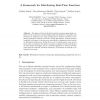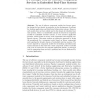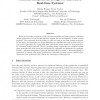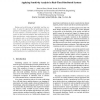OMER
2001
14 years 7 months ago
2001
: Modelling software using the Unified Modelling Language (UML) also for embedded real-time systems (ERS) becomes more and more popular since the complexity of these systems increa...
FORMATS
2008
Springer
14 years 8 months ago
2008
Springer
Abstract. The design of critical embedded real-time systems requires high confidence in the architecture and the implemented functionalities. Classically, such functions are suppor...
ATC
2008
Springer
14 years 8 months ago
2008
Springer
To overcome the rising complexity of computing systems, the paradigms of Autonomic Computing and Organic Computing have been introduced. By using an observer/controller architectur...
CBSE
2006
Springer
14 years 10 months ago
2006
Springer
Abstract. The use of software component models has become popular during the last decade, in particular in the development of software for desktop applications and distributed info...
LCTRTS
1998
Springer
14 years 10 months ago
1998
Springer
: During the latter stages of a software product cycle, developers may be faced with the task of fine-tuning an embedded system that is not meeting all of its timing requirements. ...
CP
2001
Springer
14 years 11 months ago
2001
Springer
Abstract. In this paper we consider the problem of optimal task allocation and scheduling in embedded real-time systems. This problem is far from trivial due to the wide range of c...
ADAEUROPE
2010
Springer
14 years 11 months ago
2010
Springer
Now that multicore microprocessors have become a commodity, it is natural to think about employing them in all kinds of computing, including high-reliability embedded real-time sy...
FDL
2003
IEEE
14 years 11 months ago
2003
IEEE
With the increasing complexity of the emerging embedded real-time systems, traditional design approaches can not provide sufficient support for the development of these systems an...
RTAS
2005
IEEE
15 years 1 days ago
2005
IEEE
During real-world design of embedded real-time systems, it cannot be expected that all performance data required for scheduling analysis is fully available up front. In such situa...
ECRTS
2005
IEEE
15 years 3 days ago
2005
IEEE
We present a wait-free protocol for the single-writer, multiple-reader problem in small-memory, embedded real-time systems. We analytically establish that our protocol requires le...





